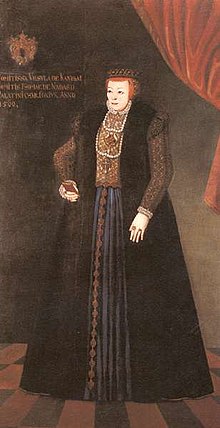Kanizsay
The Kanizsay , also Kanizsai, Kaniški (Croatian), Counts of Sprinzenmarkt, Counts of Hornstein, were a noble family in the Kingdom of Hungary in the late Middle Ages and early modern times. In its early days, this branch of the Osl clan was primarily active as a border guard of the Hungarian Gyepű system . In their heyday, family members fulfilled high ecclesiastical and secular functions as bishops in Hungary and Bane in Croatia . The name Kanizsay is derived from the southwestern Hungarian city of Nagykanizsa . The sex has been considered extinct since 1571.
Origin of the family
In the 12th and 13th centuries, the Osl family owned most of the border guards' settlements in Ödenburg County . The Kanizsay emerged from the wealthy branch of the Osl family in Csorna and became the most influential descendants of the Osl. The name Kanizsay was the first to be borne by the successors of Burgvogtes Lorenz I (Lőrinc), who in 1321 received Kanizsa Castle (owned by the Lords of Güns ) from King Karl Robert of Anjou as a reward for his loyalty in the fight against rebellious Hungarian oligarchs . In 1330 Lorenz I, who did not bear the name Kanizsay himself, died in a failed campaign against the Wallachians .
Bloom in the 14th and 15th centuries
Thanks to their loyalty to the Hungarian king, the Kanizsay gained considerable influence, especially in Ödenburg County. They acquired extensive goods in what is now Burgenland and in western Hungary. In 1365 they bought Hornstein Castle from the Wolfurt family , which they expanded into a lordship by acquiring goods from Nikolaus II. Von Pöttelsdorf, the von Roy family and the Gutkeled family . Besides Kanizsa they owned Kapuvár , Lockenhaus , Sárvár and Csepreg , among others . Numerous other rulers such as Bernstein in Burgenland and Jormannsdorf were pledged to the Kanizsay.
Nikolaus Kanizsay was a clerk in the counties of Ödenburg , Eisenburg and Zala . King Sigismund owed his success to the work of John XIV of Kanizsa († May 30, 1418), the brother of Nicholas. The king thanked the Kanizsay family by making Johann archbishop of the Diocese of Gran (Esztergom), Nicholas the chief treasurer, and in 1387 he gave the family the Kapuvár reign . As Primate of Hungary, John XIV was responsible for the fate of the Catholic Church in Hungary for many years. His function as Chancellor of the Kingdom of Hungary helped the family to gain further power.
In 1414 the last male representative of the Pöttelsdorf family died. The king declared the heirless goods forfeited and sold them to the Kanizsay. After the death of John XIV of Kanizsa in 1418, the king still held his protective hand over the family, but the lack of an influential Kanizsay personality was already noticeable. When Elisabeth , the wife of Albrecht II, gave the city of Ödenburg to Friedrich III. pledged, Emerich Kanizsay signed a protest by the Hungarian nobles against the pledging of this Kanizsay property to Austria. In the years that followed, an open feud developed between the city of Ödenburg and the surrounding castle lords . In order to put an end to the robber baron regime, King Friedrich IV. Occupied the border castles of Bernstein, Schlaining and Rechnitz in 1445 and finally gave these castles to friends of Frederick.
die out
In 1532 the male family died out with László Kanizsay. Ownership was passed on down the female line. The last descendant of the family was the daughter Lászlós Ursula Kanizsay , who, with the permission of King Szapolyai , was declared a boy at the age of nine and thus came to the enormous fortune, at that time perhaps the largest in the country. She died in 1571 as the widow of the regional judge and later palatine Thomas III. Nádasdy , with which the family died out and the property of those from Konizsa passed to the aspiring Nádasdy .
Dominions, castles and palaces
- Kanizsa Castle (1321–?)
- Sárvár Castle
- Kapuvár (1387–1532)
- Bernstein Castle (Burgenland) (from 1392 to approx. 1420)
- Schlaining Castle (around 1370)
- Hornstein Castle (1365–?)
- Lockenhaus Castle (1390 to 1535)
- Roy Castle
- Siklós Castle
- Eisenstadt Castle (1364 to 1445)
literature
- August Ernst: History of Burgenland . Verlag für Geschichte u. Politics, Vienna 1991, ISBN 3-7028-0311-4
- Josef Karl Homma : On the history of the rulership of southern Burgenland , Burgenland research, booklet 1, published by the Provincial Archives and Provincial Museum Burgenland, Ferdinand Berger publishing house, Horn-Vienna 1947
- Romana Theresia Gratzer: Life on the border depicted on the basis of the letters of Christoph von Königsberg 1567–1599 , diploma thesis at the University of Vienna , Vienna 2003
- Ignaz Aurelius Fessler: History of Hungary. Second volume , Verlag FA Brockhaus, Leipzig 1869
Web links
- Article Kanizsai in Meyer's Lexicon
- Nagykanizsa City Website (Hungarian)
- Kanizsay family tree on GENEALOGY.EU website, accessed June 12, 2012
Individual evidence
- ^ Fritz Zimmermann: The origin of some Burgenland place and person names. In: Landesarchiv and Landesmuseum Burgenland (ed.): Burgenländische Heimatblätter . Eisenstadt 1949, p. 23, PDF on ZOBODAT
- ^ Rudolf Zimmerl: The inscriptions of Burgenland. Volume 3, Part 1, Verlag A. Druckermüller, Vienna 1953, p. 28.
- ↑ The Kanizsai family on the website of the Hornstein community - with a possible representation of Hornstein Castle, accessed on August 14, 2010.
Kaniški (Croatian)

